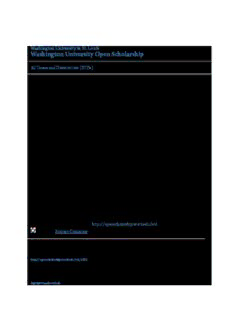
Hematopoietic Stem Cells and Progenitors in Murine Autoimmune Arthritis PDF
Preview Hematopoietic Stem Cells and Progenitors in Murine Autoimmune Arthritis
WWaasshhiinnggttoonn UUnniivveerrssiittyy iinn SStt.. LLoouuiiss WWaasshhiinnggttoonn UUnniivveerrssiittyy OOppeenn SScchhoollaarrsshhiipp All Theses and Dissertations (ETDs) Spring 3-12-2013 HHeemmaattooppooiieettiicc SStteemm CCeellllss aanndd PPrrooggeenniittoorrss iinn MMuurriinnee AAuuttooiimmmmuunnee AArrtthhrriittiiss Kwadwo Asare Oduro Jr. Washington University in St. Louis Follow this and additional works at: https://openscholarship.wustl.edu/etd Part of the Biology Commons RReeccoommmmeennddeedd CCiittaattiioonn Oduro Jr., Kwadwo Asare, "Hematopoietic Stem Cells and Progenitors in Murine Autoimmune Arthritis" (2013). All Theses and Dissertations (ETDs). 1052. https://openscholarship.wustl.edu/etd/1052 This Dissertation is brought to you for free and open access by Washington University Open Scholarship. It has been accepted for inclusion in All Theses and Dissertations (ETDs) by an authorized administrator of Washington University Open Scholarship. For more information, please contact [email protected]. WASHINGTON UNIVERSITY IN ST. LOUIS Division of Biology and Biomedical Sciences Developmental Biology Dissertation Examination Committee: Kyunghee Choi, Chair Marco Colonna Daniel Link Fanxin Long Jason Mills Deborah Novack Hematopoietic Stem Cells and Progenitors in Murine Autoimmune Arthritis by Kwadwo Asare Oduro, Jr. A dissertation presented to the Graduate School of Arts and Sciences of Washington University in partial fulfillment of the requirements for the degree of Doctor of Philosophy May 2013 St. Louis, Missouri © 2013, Kwadwo Asare Oduro, Jr. TABLE OF CONTENTS List of Figures………………………………………………………………………………………………vi List of Abbreviations………………………………………………………………………………………viii Acknowledgements…………………………………………………………………………………….…..x Abstract of the Dissertation………………………………………………………………………………xii Chapters Chapter 1: Introduction • Physiological Maintenance of the Hematopoietic System………………………………………...2 • Lineage Priming and Phenotypic Identification of Hematopoietic Progenitors………………….3 • Primitive Progenitors in Non-Physiological States – Rationale for this study …………………..4 • KRNxG7 Arthritis Model………………………………………………………………………………6 • Importance of Myeloid Cells in Arthritis……………………………………………………………..7 • Relevance of K/BxN or KRNxG7 arthritis model to Human Disease…………………………….8 • References……………………………………………………………………………………………..9 • Figures………………………………………………………………………………………………..16 Chapter 2: General Characterization of Hematopoiesis in Arthritic Mice • Overview………………………………………………………………………………………………19 • Primitive Progenitor Frequency Analysis………………………………………………………….19 o Similar Bone Marrow Primitive Progenitor Frequency and Turnover…………………19 o Increased Primitive Progenitors in Arthritic Spleen……………………………………..21 o Splenic Primitive Progenitor increase induced by T cell transfer arthritis…………….22 o Splenic Primitive Progenitor do not increase by mobilization from bone marrow……23 o Increased primitive progenitors in arthritic spleen is independent of TNFα………….25 o Summary of Primitive Progenitor Analysis……………………………………………….26 • Mature Cell and Committed Progenitor Frequency Analysis……………………………………26 ii o Defective Bone Marrow B lymphopoiesis in arthritic marrow………………………….27 o Arthritic Marrow is myeloid skewed……………………………………………………….28 o Myeloid skewing in arthritic marrow is evident at the Committed Progenitor level….29 o Erythroid and B lymphoid lineage cells expanded in extramedullary sites…………...29 • References……………………………………………………………………………………………31 • Figures………………………………………………………………………………………………...37 Chapter 3: Cell Intrinsic Molecular Differences Between Arthritic and Control Primitive Progenitors • Overview………………………………………………………………………………………………51 • Myeloid Priming in Arthritic KSL cells……………………………………………………………...52 o Arthritic KSL cells upregulate myeloid genes and downregulate erythroid genes…..52 o Induction of “Myeloid Inflammatory Signature” by Arthritogenic Serum Transfer……54 o “Myeloid Inflammatory Signature” genes are upregulated in Primitive HSCs………..55 • Features of Aging in Arthritic KSL cells……………………………………………………………56 o Elevation of IgG and P selectin proteins in Arthritic KSL cells…………………………57 • References……………………………………………………………………………………………60 • Figures………………………………………………………………………………………………..62 Chapter 4: Cell Intrinsic Functional differences between Arthritic and Control Primitive Progenitors • Overview……………………………………………………………………………………………....77 • In vitro assessment of myeloid priming…………………………………………………………….77 o Arthritic KSL cells have Increased Myeloid Potential in vitro…………………………..77 o Arthritic KSL cells have diminished Lymphopoietic Propensity in vitro……………….79 o Increased myeloid and decreased lymphoid potentials induced by serum transfer...81 • In vivo assessment of myeloid priming…………………………………………………………….81 o Arthritic KSL cells have increased myeloid potential in vivo…………………………..81 o Myeloid priming occurs in the most immature HSC fraction of arthritic KSL cells….82 iii • Molecular Mechanism of Myeloid Priming…………………………………………………………85 o Possible Roles for TLR4 and S100 proteins…………………………………………….85 • References……………………………………………………………………………………………88 • Figures………………………………………………………………………………………………...92 Chapter 5: Discussion and Future Directions • Summary of Major Findings……………………………………………………………………….104 • Disease Relevance…………………………………………………………………………………104 o Role of primitive progenitor myeloid priming in disease………………………………104 o In situ involvement of primitive progenitors in arthritis………………………………...106 • Myeloid primed primitive progenitors in arthritis and normal aging……………………………109 • Primitive progenitor identification in other diseased states…………………………………….110 Chapter 6: Experimental Procedures • Animals and Animal Treatment……………………………………………………………………118 o Animals o Arthritis Transfer Models o Mouse Antibody treatment o Tissue Preparation • Flow Cytometry……………………………………………………………………………………..121 o General Flow Cytometry o Cell Cycle and Apoptosis Analyses • Gene Expression Analysis…………………………………………………………………………123 o Microarray and Bioinformatics Analysis o Quantitative Real Time PCR • In vitro assays……………………………………………………………………………………….126 o Methylcellulose Colony Formation iv o In vitro Stromal Cell Free culture o Osteoclast In vitro assay o Differentiation on OP9 stromal cells • In vivo assays……………………………………………………………………………………….128 o General Competitive Transplantation o Young Recipient Competitive Transplantation – Supplemental Information o Old Recipient Competitive Transplantation – Supplemental Information o In situ Osteoclast Differentiaton of KSL cells • Statistics……………………………………………………………………………………………..130 • Tables Associated with Experimental Proceedures…………………………………………….130 o Antibodies used in this study o References for gene chips used for dendrogram analysis o Quantitative RT-PCR primers used in this study • References…………………………………………………………………………………………..133 v LIST OF FIGURES Chapter 1 Figure 1……………………………………………………………………………………………………16 Figure 2……………………………………………………………………………………………………17 Chapter 2 Figure 1…………………………………………………………………………………………………….37 Figure 2……………………………………………………………………………………………………39 Figure 3……………………………………………………………………………………………………41 Figure 4……………………………………………………………………………………………………43 Figure 5……………………………………………………………………………………………………44 Figure 6……………………………………………………………………………………………………46 Figure 7……………………………………………………………………………………………………47 Figure 8……………………………………………………………………………………………………48 Chapter 3 Figure 1……………………………………………………………………………………………………62 Figure 2……………………………………………………………………………………………………64 Figure 3……………………………………………………………………………………………………67 Figure 4……………………………………………………………………………………………………68 Figure 5……………………………………………………………………………………………………70 Figure 6……………………………………………………………………………………………………71 Figure 7……………………………………………………………………………………………………72 Chapter 4 Figure 1……………………………………………………………………………………………………92 Figure 2……………………………………………………………………………………………………93 vi Figure 3……………………………………………………………………………………………………95 Figure 4……………………………………………………………………………………………………96 Figure 5……………………………………………………………………………………………………97 Figure 6……………………………………………………………………………………………………99 Figure 7…………………………………………………………………………………………………..100 Figure 8…………………………………………………………………………………………………..102 vii LIST OF ABBREVIATIONS B6 C57BL/6 mice B6xG7 Progeny of crossing B6 and G7 mice B6xKRN Progeny of crossing B6 and KRN mice BM Bone Marrow BrdU Bromodeoxyuridine CLP Common Lymphoid Progenitor c-Mpl Myeloproliferative Leukemia Virus Oncogene EMH Extramedullary Hematopoiesis FACS Fluorescence Activated Cell Sorting G7 B6 congenic mice with MHC II I-Ag7 instead of I-Ab G-CSF Granulocyte Colony Stimulating Factor GFP Green Fluorescent Protein GMP Granulocyte Monocyte Progenitor HSC Hematpoietic Stem Cell IFN Interferon Ig Immunoglobulin IgH Immunoglobulin Heavy Chain IL Interleukin K/BxN Progeny of crossing KRN and NOD mice KRN A T cell receptor transgene or mice with this transgene KRNxG7 Progeny of crossing KRN and G7 mice KSL Kit+Sca1+Lin- Lin Lineage (Mature Cell) Markers LPS Lipopolysaccharide LT-HSC Long Term Reconstituting Hematopoietic Stem Cell viii
Description: